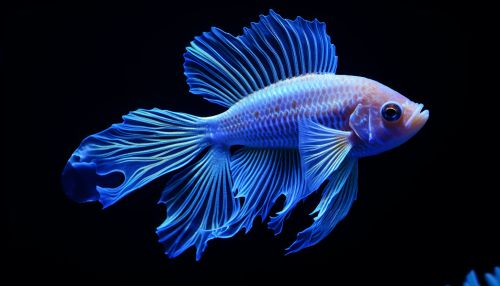Biofluorescence
Introduction
Biofluorescence refers to the phenomenon where an organism absorbs light, transforms it, and re-emits it as a different color. This is a form of luminescence, and is distinct from bioluminescence, where light is produced through a chemical reaction within the organism. Biofluorescence is observed in a variety of organisms, including certain species of fish, reptiles, amphibians, birds, and invertebrates.


Mechanism
The mechanism of biofluorescence involves three stages: absorption, transformation, and emission. The organism absorbs light of a certain wavelength, usually in the ultraviolet (UV) or blue spectrum. This light energy excites electrons within the fluorescent molecules, causing them to move to a higher energy state. When the electrons return to their normal state, they release the energy as light of a longer wavelength, which is usually green, red, or far-red.
The fluorescent molecules involved in biofluorescence are known as fluorophores. These are typically proteins or small organic compounds. The exact nature and structure of these fluorophores can vary widely between different organisms, and can greatly influence the color and intensity of the emitted light.
Function
The function of biofluorescence in organisms is not fully understood and is likely to vary between species. Some potential functions include communication, camouflage, prey attraction, and protection from harmful UV radiation.
In some species, biofluorescence may play a role in mating or other forms of social interaction. For example, some species of fish and reptiles are known to display fluorescent patterns that are only visible to members of their own species. This could potentially serve as a form of private communication that is hidden from predators.
Camouflage is another potential function of biofluorescence. Some organisms, such as certain species of cephalopods and fish, can change the color and pattern of their biofluorescence to match their surroundings. This can help them to blend in and avoid detection by predators.
In other cases, biofluorescence may be used to attract prey. Some species of scorpions, for example, are known to glow under UV light. This could potentially attract insects, which are attracted to UV light, towards the scorpion.
Protection from UV radiation is another possible function of biofluorescence. The fluorescent molecules can absorb harmful UV light and re-emit it as harmless visible light, thereby protecting the organism's tissues from damage.
Distribution
Biofluorescence is widely distributed across the tree of life. It is observed in a variety of marine organisms, including fish, cephalopods, crustaceans, and cnidarians. In terrestrial environments, biofluorescence is observed in some species of birds, reptiles, amphibians, and insects.
Marine environments, particularly coral reefs, are hotspots for biofluorescence. This is likely due to the abundance of blue light in these environments, which is the preferred wavelength for many fluorescent molecules. The high diversity of organisms in these environments also contributes to the wide variety of fluorescent colors and patterns observed.
In terrestrial environments, biofluorescence is less common but still present in a diverse range of organisms. Some species of birds, for example, are known to display fluorescent patterns on their feathers. Similarly, some species of reptiles and amphibians display fluorescent patterns on their skin.
Detection and Study
The study of biofluorescence involves the use of specialized equipment to detect and analyze the emitted light. This typically involves the use of a light source to excite the fluorescent molecules, and a filter to separate the emitted light from the excitation light.
In recent years, advances in technology have greatly improved our ability to detect and study biofluorescence. High-resolution imaging techniques, such as confocal microscopy and spectral imaging, have allowed researchers to visualize and analyze fluorescent patterns in unprecedented detail. Similarly, advances in genetic techniques have allowed researchers to identify and study the genes responsible for biofluorescence.
Despite these advances, our understanding of biofluorescence is still limited. Many questions remain about the function, evolution, and ecological significance of this phenomenon. Further research is needed to fully understand the role of biofluorescence in the biology of organisms.
